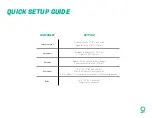
USING THE RUNNER WHILE RACING
In light air under 6 knots and with the crew on the deck, you are most likely wanting to go fast forward. Only a touch of lower runner needs to be used,
it is easier for the top batten to be hooked because of the weight of the boom so there is no need for the upper to be on.
In 6 to 8 knots of air and with the crew beginning to hike harder, the goal is to have the top batten parallel to the boom or 5˚ open with about 3” of
lower runner on. This will help to round out the mainsail behind the mast at the spreader window, which helps the boat to go faster with the increase
in breeze velocity. Speed and power will lead to better height on the racecourse. By pulling on a little runner, the sail plan has the ability to deliver the
ideal speed around the course.
Once the skipper and crew are fully hiked, the next step is to make an adjustment to increase speed forward while maintaining height. Do this by
flattening the mainsail with a firm mainsheet, taking a bit off the lower runner, and adding more twist. The upper backstay can slowly be added now
to keep the forestay tighter in the developing chop. Often you will see diagonal wrinkles across the window; this is typically a fast forward mode. If the
mainsail is smooth over the windows and there is no wrinkle across the vertical seam, you will likely be high and slow.
When the wind gets to 18+ knots, pull firm on the cunningham to bring the draft forward. The rake may be eased to help induce more twist. The upper
is pulled hard, and the lower is pulled firm to keep the sail from luffing in the puffs. The goal at this wind range is to give the driver the most balance
and control possible.
The exact mainsail shape and boat setup is different for each condition, so it’s best for a racer is to get to the course early for speed testing with other
boats to find the best setup for each day.
RUNNER TIPS
S TA R / T UNIN G GUIDE
Содержание STAR
Страница 1: ...STAR TUNING GUIDE ...





























